Development of a System Dynamics Simulation for Assessing Manufacturing Systems Based on the Digital Twin Concept
Abstract
:Featured Application
Abstract
1. Introduction
2. Methodology, Fundamentals, and Materials
2.1. Methodology
- Literature research on the manufacturing process, manufacturing system, elements, flows, parameters, system dynamics, simulation, and the integrated manufacturing model.
- Design of a case study for the metallurgical industry to test a novel conceptual model for modeling and assessing manufacturing systems. After developing the conceptual model, it is applied to a simulation case study using system dynamics. The case study consists of a metallurgical process from steelmaking to finishing steps. In addition, the simulation model is developed using system dynamics. Based on the simulation study, the interrelationships and impacts of manufacturing areas and factors are analyzed and described.
- Execution of simulation experiments for a comparison of the conceptual model with other manufacturing models in different demand and variability element scenarios. The objective is to determine what the effects of the integrated manufacturing model are and how it can improve the relevant key performance indicators based on a complete consideration of factors, thereby allowing the prediction of variability elements and their probability, and enabling an effective definition of preventive maintenance plans for all related flows.
- Interpretation of results and derivation of implications and use cases for managers and technicians.
- Critical reflection of the research performed, and outlook of potential future research based on the findings of paper.
2.2. Manufacturing Model
- Input: information, material, money, and energy flows.
- Process: the capital equipment status and the impacts of human resource functions, information flows, and related maintenance activities.
- Regulation mechanisms: maintenance management and control, quality management and control, process design and optimization, and the order flows that are the decisions that influence the system from both the current and future states.
- Finally, the output areas are the information, material, money, and energy flows obtained because of the manufacturing process and the related transformation from the input to the output item. Furthermore, an important output is the quality control of output according to quality requirements. Moreover, the main goal of logistics is to be able to provide the right products in the right quantity and quality with full information at the right time and at the right place [17].
2.3. Manufacturing Process Simulation and Digital Twins
2.4. Materials
- Books, conferences, and articles from the literature research.
- System theory and cybernetics: Cybernetics can be considered part of systems theory. Both sciences deal with essentially the same subject; however, system theory focuses on the development of systems, while cybernetics explores the control and operation of systems [20]. The general object of consideration in cybernetics is systems. These systems are defined by a number of objects that are mutually connected through dynamic relationships and common properties. The boundary of a system is subjective in nature and must be defined by the observer [21]. Cybernetics deals with all forms of behavior, insofar as they are regular, determinate, or reproducible. As a result, it cares about what a system can perform [22]. On the other hand, there are two different cybernetic approaches to how to study a system: first-order and second-order cybernetics. First-order cybernetics study a system as if it were a “thing” that can be observed, manipulated, and separated. Second-order cybernetics, on the other hand, treat that system as an agent with its own entity that interacts with another agent, the observer [23]. A fundamental component of cybernetic systems are control loops, in which constant parameters are kept within the system. Under a control loop, there is an evolution of the effects that originate through the feedback of output factors in input factors [24]. In this way, control loops allow systems to be able to regulate themselves by comparing target and actual values through feedback mechanisms. In this research paper, the model is a system in which the interrelationships among the flows and different models are developed based on a model without regulation, a model with first-order cybernetics regulation, and with a second-order cybernetics regulation.
- Modeling is the representation of a real-world scenario by a mathematical expression and/or a simplification of the real-world system. Simulation uses a model to generate data, and these data can then be analyzed [25]. Simulation allows companies to assess how decisions should be made and the optimal time to make them. Therefore, these analyses can assist in determining whether certain decisions are wise or not, acting as a decision supporting tool [26]. The use of simulation for manufacturing system design and analysis is recognized by scientists and industrial managers [27]. Simulations will be used more extensively in manufacturing operations to make use of real-time data to copy the physical world in a virtual model, which can include machines, products, and humans, thereby optimizing machine availability, increasing quality, as well as reducing production failures and improving decision making quality [6].
- System dynamics simulation: This type of continuous simulation is chosen over discrete simulations, such as discrete-event or agent-based modeling, due to its high abstraction level that represents global causal dependencies with aggregates and feedback dynamics supporting the integral assessment and selection of strategic alternatives of a manufacturing system.
- Simulation software: There are different software packages on the market that enable system dynamics modeling [28]. Out of them, VENSIM (Ventana Systems) simulation software was selected for this research.
- Data bases served as input data for simulation.
3. Simulation Model Development
3.1. Delimitation of the Model
3.2. Model Development Steps
- Manufacturing process modeling for Industry 4.0;
- Analysis of interrelationships and generation of a casual loop diagram (CLD);
- Methodology for the application of the conceptual model to assess specific manufacturing processes;
- Definition of key performance indicators (KPIs);
- Simulation logic definition for the assessment of manufacturing systems and processes;
- Description of simulation models;
- Definition of simulation scenarios;
- Validation of the simulation model;
- Extraction of simulation results and their interpretation.
3.3. Manufacturing Process Modeling for Industry 4.0
3.4. Interrelationships and Casual Loop Diagrams (CLDs)
4. Manufacturing Process Case Study
4.1. Design of the Case Study for a Metallurgical Process
- The product is a finished/sale product after the final inspection process.
- The orders have only one product type, shot-peened round bars.
- Demand level is based on customer orders, and it is the same for the same scenario in the different simulation models.
- The manufacturing system follows a make-to-order production system.
- The manufacturing system initiates the simulation with work-in-progress (WIP) units along the production steps and warehouses.
- There is no transport limitation or transport means limitation in the different stages.
- Replenishment times between stages at the beginning of the case study have the same distribution over the period considered.
- Order information along the manufacturing system is available.
- Demand is not known, but historical data for all customers are available one day after orders are placed.
- Customers do not leave the company or order more if the last orders are not met on time.
- At the beginning, all employees have the same experience and have the same capacity to perform warehouse activities.
- Production capacity is always between a minimum and a maximum, given a capacity per shift and the number of employees, if no decision has been taken during the simulation. The minimum and maximum production capacities per shift are the same for all models at the beginning of the simulation study.
- Storage capacities have a maximum level, and it is the same for all models at the beginning of the simulation.
- Products do not suffer any kind of problems/failure in their transportation from the production facility to the customers.
- Packaging is performed in the production facility.
- Safety stock levels change as required for the target service level. The target service level is calculated based on the reorder point method.
- Monetary means to finance the manufacturing process are assumed as given.
- Market demand is defined by values read from a database outside of the model. Demand defines the evolution of customer orders.
- Production capacity has a maximum of 4000 units per day in three shifts at the beginning of the simulation. During the simulation, the capacity levels of the different production processes within the manufacturing system are affected by the information received, the material available, the energy supply, the quantity and qualification of personnel and capital equipment, and the monetary capability.
- Storage capacity at the beginning of the simulation is 3000 units.
- There are three working shifts at the beginning of the simulation.
- Personnel capacity at the beginning of the simulation is 1200 employees.
- The replenishment times are set at the beginning of the simulation and do not change over the simulation period.
4.2. Key Performance Indicators (KPIs) for the Case Study
- Cumulated demand (tons): this represents the cumulated demand to be satisfied in a certain period:
- Information availability (% information needed): this represents the information received of the total information needed to manufacture the production orders in a certain period:
- Material procurement reliability (% material needed): this represents the available material input of the total of material input required to produce the orders planned in a certain period:
- Energy availability (% energy needed): this represents the available energy input of the total of energy input required to produce the orders planned in a certain period:
- Capital equipment (% capital equipment needed): this represents the available capital equipment of the total of capital equipment required to produce the orders planned in a certain period:
- Personnel availability (products): this represents the available staff of the total of human resources required to produce the orders planned in a certain period:
- OEE (overall equipment effectiveness): This is a well-known measurement method that combines availability, performance, and quality for the evaluation of equipment effectiveness in the manufacturing industry [34]. The OEE index machine stands in comparison with an ideal machine that always runs at full speed and capacity, while at the same time producing good quality products [25]. Although the data of overall effectiveness of equipment seem very simple, extracting useful information from a series of calculations is an important and difficult task [35,36].
- The next three rates are used for both the manufacturing system and process step:
- ○
- Availability factor: In detail, the availability factor measures the time loss due to breakdowns, set-up, adjustment, and other stoppages [19]. It is traditionally calculated using Nakajima’s [37] formula as shown below [34]. However, in this paper, it is calculated as a multiplication of the areas availabilities.
- ○
- Performance rate: This takes into account “speed loss”. Reasons for this can be substandard materials, operator inefficiency, and job conditions. Then, performance is determined as follows [38]:
- ○
- Quality rate: Quality considers “product loss”, which is determined as follows [38]:
- Average WIP stock (products): This is the average stock after production until reaching end customers. Inventory is also one of the most important drivers in a distribution network [16]:
- Labor productivity (tons/(employee*day)): This is the output with quality for each employee per day:
- Process capability (Cpk): The Cpk is an index that measures how close a process is running to its specification limits compared to the natural variability of the process. The larger the index, the less likely it is that any item will be outside the specifications.
4.3. Simulation Logic for Assessing the Manufacturing System
“For a manufacturing process to take place, it is needed to secure the money flow; it is fundamental to prepare and provide the necessary information about the management and technical conditions of the process, including the technical parameters, the energy needed, and the material input required. Moreover, it is key to describe and coordinate the availability of the required human resources in quantity and qualification as well as to describe and provide the necessary capital equipment, such as machine and tools”.
4.4. Simulation Models
- Manufacturing process system modeling as explained in Figure 1:
- Input–output process without controller or regulation: This characteristic implies that the model will not change its behavior depending on the system status or target KPIs. The logical and mathematical formulations that govern the transformation of the inputs into outputs of this model are defined and do not change over the simulation period.
- First-order cybernetics: The process of controlling the system with an integrated control that changes the model behavior with a determined pattern, i.e., within a given framework or policy for transforming inputs into outputs, it can modify parameters to meet target objectives; however, it cannot adapt the controlling policies of the system behavior.
- Second-order cybernetics: regulate the system behavior with an integrated control that can change its patterns based on the system status, targets, and self-optimization options, i.e., the model can change its policies in different areas such as maintenance, quality, etc., to adapt itself to achieve the intended objectives.
- Maintenance policy: Describes the maintenance strategy applied in all production steps of the metallurgical case study:
- Corrective: defines a model in which maintenance activities are performed when there is a breakdown that implies a production stop in the process.
- Preventive: describes a model that realizes maintenance activities in fixed intervals to prevent breakdowns from occurring and having an impact on the system.
- Predictive: a policy in which intervals depend on a forecast of maintenance needs and, therefore, generating activities in variable maintenance intervals depending on the prediction.
- Quality control: reflects the consideration of product quality output and how the adjustments to achieve the target product quality are performed:
- Without adjustments: independently of the quality output, the system does not change.
- With adjustments: depending on the quality output, model parameters change with a fixed pattern.
- Predictive adjustments based on self-regulation: depending on the quality output and prediction of quality rate, model parameters change.
- Areas in focus: pursues to compare a classical approach in which the material flow was mainly the only flow affecting the manufacturing system and process availability versus an approach in which all flow areas related to the manufacturing system are considered and monitored:
- Only material flow area is in focus: implies that material is the only flow area with monitoring and action derived from its status.
- All areas are in focus: this means that money, information, material, energy, personnel, and capital equipment will be monitored and treated with equal procedures.
- Classical simulation model: consists of 1a, 2a, 3a, and 4a;
- Integrated manufacturing simulation model: consists of 1b, 2b, 3b, and 4b;
- Integrated manufacturing simulation model with regulation: consists of 1c, 2c, 3c, and 4b. Self-optimization aims to combine the advantages of cybernetic and deterministic models to design systems that are able to change their internal state or structure endogenously according to changes in the external conditions [33].
4.5. Scenarios
4.6. Simulation Model Validation
- For a lower number of employees, the OEE, the manufacturing system availability, and the production of finished products must be lower, while more demand is delivered with delay. This is expected as employees are the ones performing maintenance activities among others, as well as assuring the availability of the flow areas needed to perform the manufacturing process, and therefore, a lower quantity of employees implies a capacity deficit to meet customer demands, i.e., less production and higher delivery delays while the availability and OEE are lower. Figure 7 shows this behavior; red and blue lines represent a higher and lower number of employees, respectively.
4.7. Simulation Results
5. Discussion
- Record the current state of the manufacturing system.
- Develop a digital twin model of the manufacturing system.
- Use the digital twin model for simulation purposes.
- Design a systematic methodology with the goal of identifying all potential bottlenecks that can occur for different future scenarios.
- Derive a set of alternatives to solve the potential bottlenecks.
- Decision-making on measures to be included on the existing action plan.
- Follow-up of the action plan with pre-defined indicators and criteria in a rolling basis.
- Use the comparison of real to virtual data to improve the adherence to reality of the digital twin model by improving the interrelationships established and the simulation capabilities.
6. Conclusions
- A simulation modeling framework for Industry 4.0 based on second-order cybernetics is developed.
- The interrelationships among manufacturing system areas are described.
- Managerial conclusions:
- The current challenges and opportunities for manufacturing systems, digital twins, and manufacturing simulation were described.
- The selected conceptual model applied to digital twin models can be a key tool in managerial decision making.
- Global optimization of the production system.
- Higher manufacturing system availability.
- Higher product quality.
- Higher system performance.
- Higher delivery reliability.
- Limitations of the research work:
- Individual interactions among staff, machines, robots, and other elements were not considered in the simulation model.
- The simulation lacks feedback of the real system with real-time data from the manufacturing plant.
- The complexity of the metallurgical manufacturer was partially built in the simulation model.
- The complexity of processes such as steelmaking was not built in detail.
- The organization structure and interfaces were not considered in the simulation model.
- Certain quality requirements of the product were not considered.
- Investment and costs were assumed.
- Future research based on this study’s findings could focus on the following:
- Transferring this research method to real production systems and applying it as a digital twin tool or an assistance tool for sales, production, quality, and maintenance leaders by centralizing all data related to the manufacturing system, thereby allowing the simulation of what-if-scenarios, as well as for the monitoring and assessment of the manufacturing system state.
- Considering organization units and their communication within the simulation model.
- Improving the model based on implementation feedbacks as well as applying it to production networks with several production plants.
Author Contributions
Funding
Institutional Review Board Statement
Informed Consent Statement
Conflicts of Interest
References
- Stich, V.; Oflazgil, K.; Schröter, M.; Reschke, J.; Jordan, F.; Fuhs, G. Big data implementation for the reaction management in manufacturing systems. In Proceedings of the 2015 XXV International Conference on Information, Communication and Auto-mation Technologies (ICAT), Sarajevo, Bosnia and Herzegovina, 29–31 October 2015; pp. 1–6. [Google Scholar]
- Chen, B.; Wan, J.; Shu, L.; Li, P.; Mukherjee, M.; Yin, B. Smart factory of Industry 4.0: Key technologies, application case, and challenges. IEEE Access 2017, 6, 6505–6519. [Google Scholar] [CrossRef]
- Ashby, W.R. Principles of the self-organizing system. In Facets of Systems Science; Springer: Boston, MA, USA, 1991; pp. 521–536. [Google Scholar]
- Wiendahl, H.P.; ElMaraghy, H.A.; Nyhuis, P.; Zäh, M.F.; Wiendahl, H.H.; Duffie, N.; Brieke, M. Changeable manufac-turing-classification, design and operation. CIRP Ann. 2007, 56, 783–809. [Google Scholar] [CrossRef]
- Magnanini, M.C.; Tolio, T.A. A model-based Digital Twin to support responsive manufacturing systems. CIRP Ann. 2021, 70, 353–356. [Google Scholar] [CrossRef]
- Vaidya, S.; Ambad, P.; Bhosle, S. Industry 4.0–a glimpse. Procedia Manuf. 2018, 20, 233–238. [Google Scholar] [CrossRef]
- Cortés, C.B.Y.; Landeta, J.M.I.; Chacón, J.G.B. El entorno de la industria 4.0: Implicaciones y perspectivas futuras. Concienc. Tecnológica 2017, 54, 33–45. [Google Scholar]
- Negri, E.; Fumagalli, L.; Macchi, M. A review of the roles of digital twin in CPS-based production systems. Procedia Manuf. 2017, 11, 939–948. [Google Scholar] [CrossRef]
- Schilberg, D.; Meisen, T.; Reinhard, R. Virtual Production-The connection of the modules through the Virtual Pro-duction Intelligence. In Proceedings of the World Congress on Engineering and Computer Science 2013, San Francisco, CA, USA, 23–25 October 2013; Volume 2, pp. 23–25. [Google Scholar]
- Thombansen, U.; Schuttler, J.; Auerbach, T.; Beckers, M.; Buchholz, G.; Eppelt, U.; Gloy, Y.-S.; Fritz, P.; Kratz, S.; Klocke, F.; et al. Model-based self-optimization for manufacturing systems. In Proceedings of the 2011 17th International Conference on Concurrent Enterprising, Aachen, Germany, 20–22 June 2011; pp. 1–9. [Google Scholar]
- Resman, M.; Pipan, M.; Šimic, M.; Herakovič, N. A new architecture model for smart manufacturing: A performance analysis and comparison with the RAMI 4.0 reference model. Adv. Prod. Eng. Manag. 2009, 14, 153–165. [Google Scholar] [CrossRef] [Green Version]
- Wang, Y.; Towara, T.; Anderl, R. Topological approach for mapping technologies in reference architectural model Industrie 4.0 (RAMI 4.0). In Proceedings of the World Congress on Engineering and Computer Science, San Francisco, CA, USA, 25–27 October 2017; Volume 2, pp. 25–27. [Google Scholar]
- Suri, K.; Cadavid, J.; Alferez, M.; Dhouib, S.; Tucci-Piergiovanni, S. Modeling business motivation and underlying processes for RAMI 4.0-aligned cyber-physical production systems. In Proceedings of the 2017 22nd IEEE International Conference on Emerging Technologies and Factory Automation (ETFA), Limassol, Cyprus, 12–15 September 2017; pp. 1–6. [Google Scholar]
- Reschke, J.; Gallego-García, S. A Novel Methodology for Assessing and Modeling Manufacturing Processes. Appl. Sci. 2021, 11, 10117. [Google Scholar] [CrossRef]
- Qin, J.; Liu, Y.; Grosvenor, R. A categorical framework of manufacturing for Industry 4.0 and beyond. Procedia Cirp 2016, 52, 173–178. [Google Scholar] [CrossRef] [Green Version]
- Wang, S.; Wan, J.; Li, D.; Zhang, C. Implementing smart factory of industrie 4.0: An outlook. Int. J. Distrib. Sens. Netw. 2016, 12, 3159805. [Google Scholar] [CrossRef] [Green Version]
- Schuh, G.; Stich, V.; Wienholdt, H. Logistikmanagement; Springer: Berlin/Heidelberg, Germany, 2013. [Google Scholar]
- Perales, D.P.; Valero, F.A.; García, A.B. Industry 4.0: A classification scheme. In Closing the Gap between Practice and Research in Industrial Engineering; Springer: Cham, Switzerland, 2018; pp. 343–350. [Google Scholar]
- Wang, X.V.; Xu, X.W. An interoperable solution for cloud manufacturing. Robot. Comput.-Integr. Manuf. 2013, 29, 232–247. [Google Scholar] [CrossRef]
- Schwaninger, M. Systemtheorie. In Erweiterte Fassung des Beitrags ‘Systemtheorie’ zum Handwörterbuch der Produktionswirtschaft, 3rd ed.; Schäffer-Poeschel Verlag: Stuttgart, Germany, 2004. [Google Scholar]
- Beer, S. Kybernetik und Management; S. Fischer Verlag: Frankfurt, Germany, 1962. [Google Scholar]
- Ashby, W.R. An Introduction to Cybernetics; Chapmand & Hall Ltd.: London, UK, 1957. [Google Scholar]
- Heylighen, F.; Joslyn, C. Cybernetics and second order cybernetics. Encycl. Phys. Sci. Technol. 2001, 4, 155–170. [Google Scholar]
- Groten, M. Integrierte Planung von Distributionsnetzwerken auf Basis des Viable-System Models; Apprimus Verlag Aachen: Aachen, Germany, 2017. [Google Scholar]
- Mittal, S.; Khan, M.A.; Romero, D.; Wuest, T. Smart manufacturing: Characteristics, technologies and enabling factors. Proc. Inst. Mech. Eng. Part B J. Eng. Manuf. 2019, 233, 1342–1361. [Google Scholar] [CrossRef]
- Keddis, N.; Kainz, G.; Buckl, C.; Knoll, A. Towards adaptable manufacturing systems. In Proceedings of the 2013 IEEE International Conference on Industrial Technology (ICIT), Cape Town, South Africa, 25–28 February 2013; pp. 1410–1415. [Google Scholar]
- Habchi, G.; Berchet, C. A model for manufacturing systems simulation with a control dimension. Simul. Modeling Pract. Theory 2003, 11, 21–44. [Google Scholar] [CrossRef]
- Campuzano, F.; Bru, J.M. Supply Chain Simulation: A System Dynamics Approach for Improving Performance; Springer Science & Business Media: Berlin/Heidelberg, Germany, 2011. [Google Scholar]
- Bonney, M.; Jaber, M.Y. Environmentally responsible inventory models: Non-classical models for a non-classical era. Int. J. Prod. Econ. 2011, 133, 43–53. [Google Scholar] [CrossRef]
- 19226, DIN: Leittechnik, Regelungstechnik und Steuerungstechnik. Allgemeine Grundbegriffe, Teil 1; Deutsches Institut für Normung: 1994. Available online: https://www.beuth.de/de/norm/din-19226-1/2229987 (accessed on 10 January 2022).
- Frank, U.; Giese, H.; Klein, F.; Oberschelp, O.; Schmidt, A.; Schulz, B.; Vocking, H.; Witting, K. Selbstoptimierende systeme des maschinenbaus. Definitionen und Konzepte. In Sonderforschungsbereich; Deutschen Forschungemeinschaft: Paderborn, Germany, 2004; p. 614. [Google Scholar]
- Zürn, M. Referenzmodell für die Fabrikplanung auf Basis von Quality Gates; Jost Jetter Verlag: Heimsheim, Germany, 2010. [Google Scholar]
- Auerbach, T.; Bauhoff, F.; Beckers, M.; Behnen, D.; Brecher, C.; Brosze, T.; Esser, M. Selbstoptimierende produktionssysteme. In Integrative Produktionstechnik Für Hochlohnländer; Springer: Berlin, Germany, 2011; pp. 747–1057. [Google Scholar]
- Ramsauer, C. Industrie 4.0–die produktion der Zukunft. WINGbusiness 2013, 3, 6–12. [Google Scholar]
- Oztemel, E.; Gursev, S. Literature review of Industry 4.0 and related technologies. J. Intell. Manuf. 2020, 31, 127–182. [Google Scholar] [CrossRef]
- Tao, F.; Qi, Q. New IT driven service-oriented smart manufacturing: Framework and characteristics. IEEE Trans. Syst. Man Cybern. Syst. 2017, 49, 81–91. [Google Scholar] [CrossRef]
- Mourtzis, D.; Angelopoulos, J.; Boli, N. Maintenance assistance application of Engineering to Order manufacturing equipment: A Product Service System (PSS) approach. IFAC-PapersOnLine 2018, 51, 217–222. [Google Scholar] [CrossRef]
- Elevli, S.; Elevli, B. Performance measurement of mining equipments by utilizing OEE. Acta Montan. Slovaca 2010, 15, 95. [Google Scholar]
- Dhilon, B.S. Maintainability, Maintenance and Reliability for Engineers; Taylor and Francis: Boca Raton, FL, USA, 2006. [Google Scholar]
- Jonsson, P.; Lesshammar, M. Evaluation and improvement of manufacturing performance measurement systems—The role of OEE. Int. J. Oper. Prod. Manag. 1999, 19, 55–78. [Google Scholar] [CrossRef] [Green Version]
- Hinckeldeyn, J.; Dekkers, R.; Altfeld, N.; Kreutzfeldt, J. Bottleneck-based synchronisation of engineering and manufacturing. In Proceedings of the 19th International Conference on Management of Technology., Cairo, Egypt, 8–11 March 2010. [Google Scholar]
- Blackstone, J. APICS Dictionary, 12th ed.; 12. Aufl.; APICS—The Association for Operations Management: Chicago, IL, USA, 2008. [Google Scholar]
- Schuh, G.; Potente, T.; Hauptvogel, A. Cyber-physische feinplanung. Hochauflösende Prod. Auf Basis Kybern. Unterstützungssysteme 2013, 4, 336–339. [Google Scholar]
- Sterman, J.D. Business Dynamics: Systems Thinking and Modeling for a Complex World; Irwin/McGraw-Hill: New York, NY, USA, 2000. [Google Scholar]
- Wensing, T. Periodic Review Inventory Systems; Springer: Berlin, Germany, 2011; Volume 651. [Google Scholar]
- Liu, M.; Fang, S.; Dong, H.; Xu, C. Review of digital twin about concepts, technologies, and industrial applications. J. Manuf. Syst. 2021, 58, 346–361. [Google Scholar] [CrossRef]
- Lu, Y.; Liu, C.; Kevin, I.; Wang, K.; Huang, H.; Xu, X. Digital Twin-driven smart manufacturing: Connotation, reference model, applications and research issues. Robot. Comput.-Integr. Manuf. 2020, 61, 101837. [Google Scholar] [CrossRef]

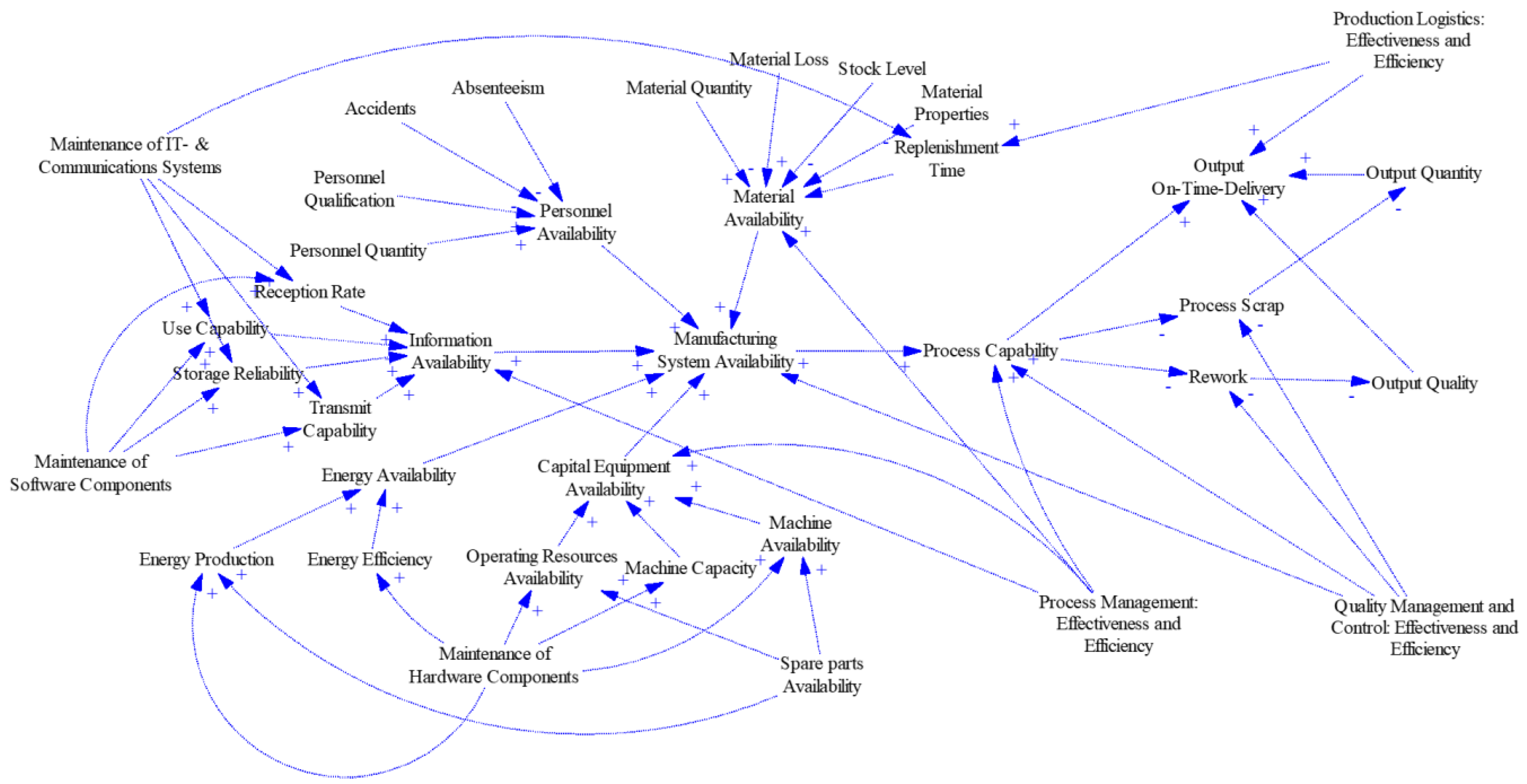


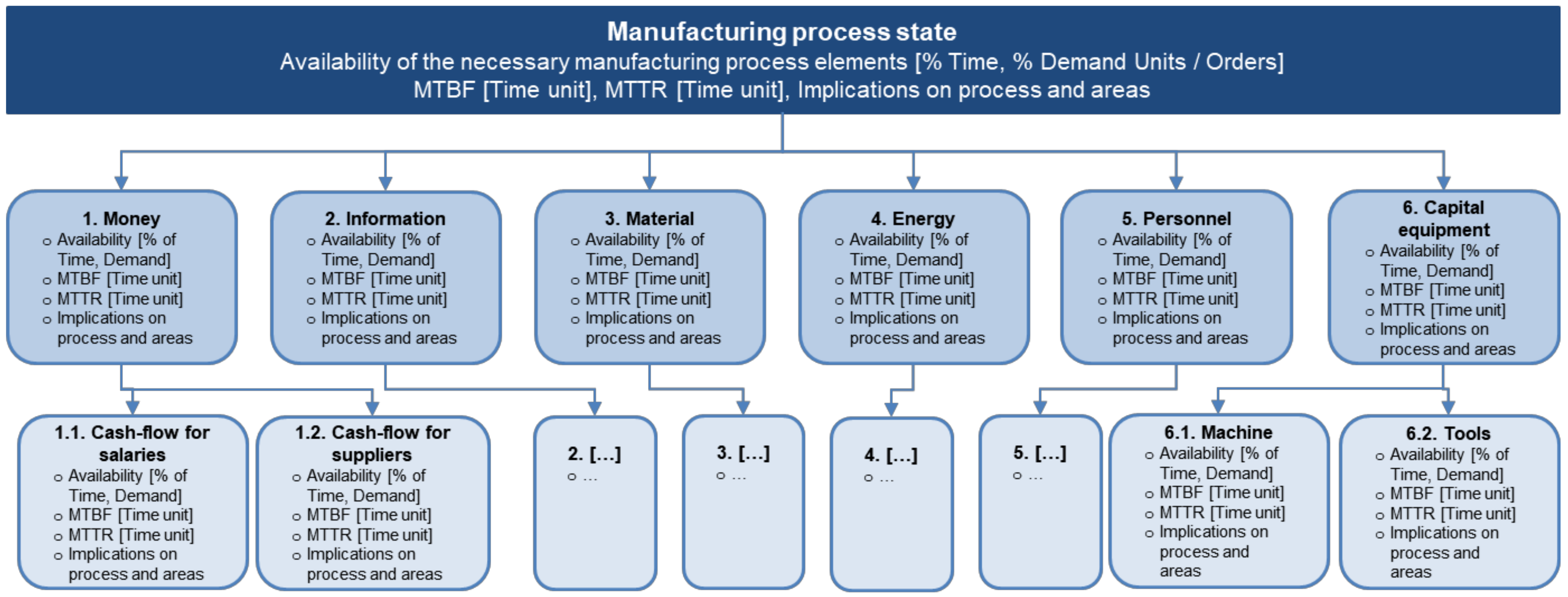

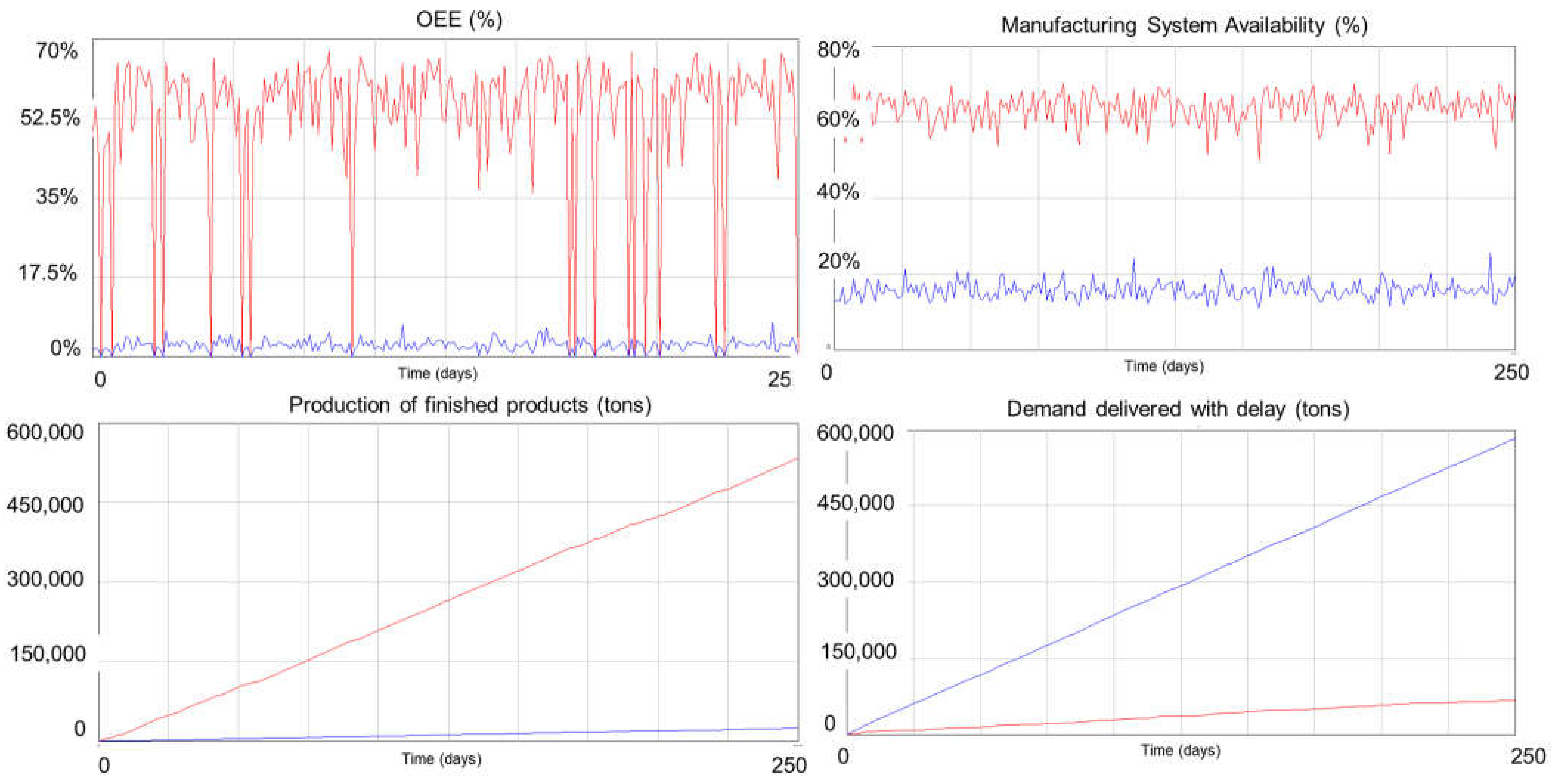
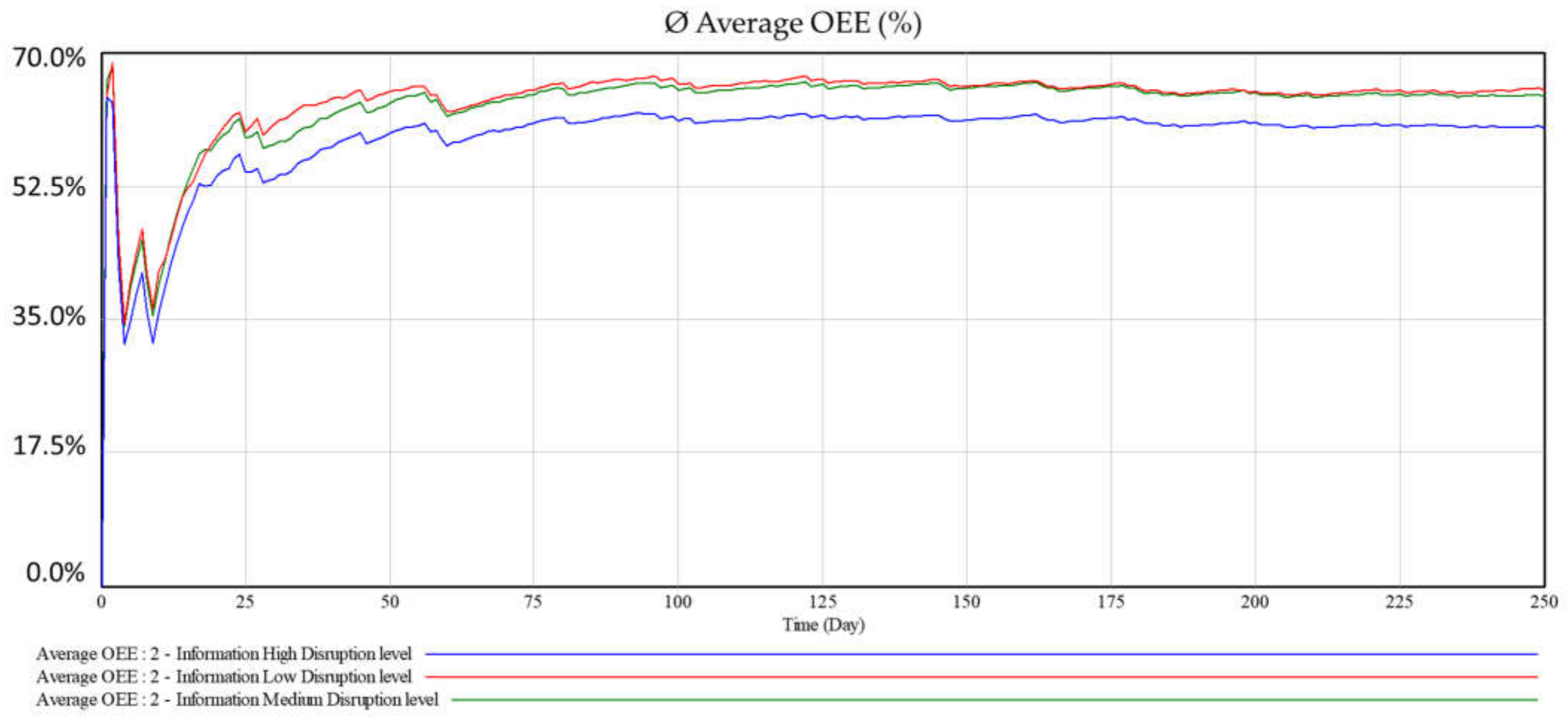
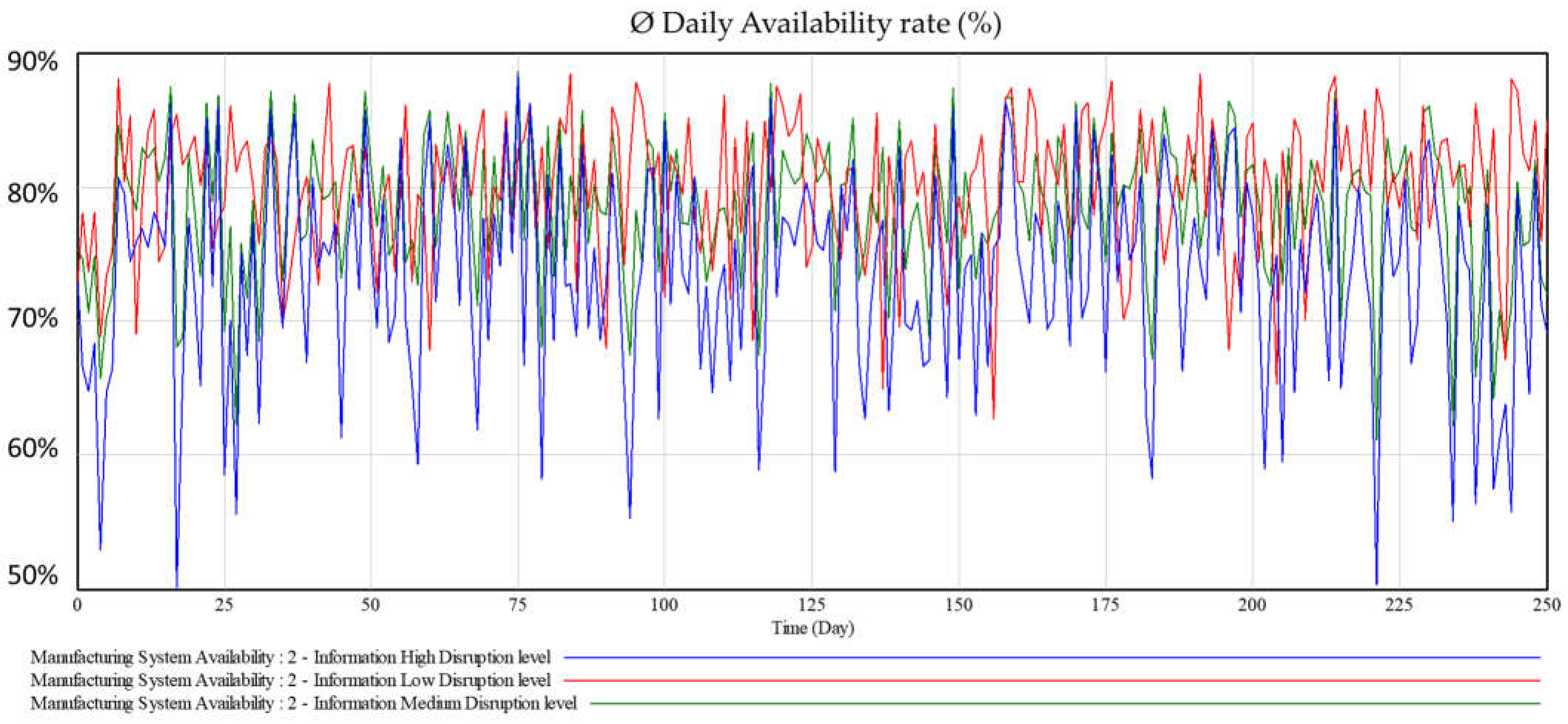
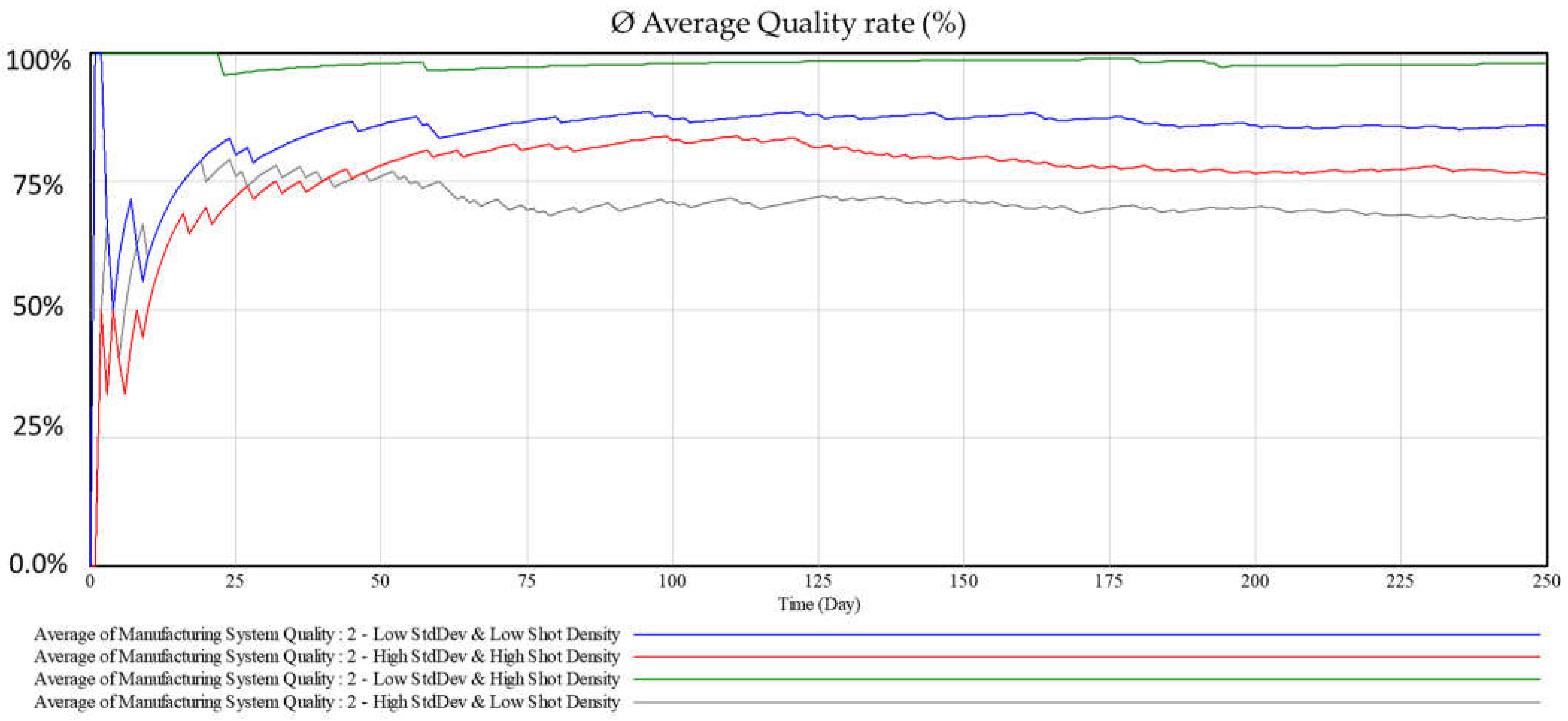
| No. | Areas | Money | Information | Material | Energy | Personnel | Maintenance | Process | Equipment | Output |
|---|---|---|---|---|---|---|---|---|---|---|
| 1 | Money | X | ||||||||
| 2 | Information | [X] | X | X | X | X | X | X | X | |
| 3 | Material | (X) | X | X | ||||||
| 4 | Energy | (X) | X | |||||||
| 5 | Personnel | (X) | X | X | ||||||
| 6 | Maintenance | (X) | X | |||||||
| 7 | Process | (X) | (X) | (X) | (X) | (X) | X | |||
| 8 | Capital Equipment | (X) | (X) | (X) | X |
| No. | Key Indicator | 1. Classical Simulation Model | 2. Integrated Manufacturing Simulation Model | 3. Integrated Manufacturing Simulation Model with Regulation |
|---|---|---|---|---|
| 1 | ∑ Demand (tons) | 608,660 | 608,660 | 608,660 |
| 2 | Ø Money availability (%) | 100 | 100 | 100 |
| 3 | Ø Information availability (%) | 91.0 | 93.8 | 95.8 |
| 3 | Ø Material availability (%) | 93.1 | 96.0 | 100 |
| 4 | Ø Energy availability (%) | 91.0 | 93.8 | 95.8 |
| 6 | Ø Personnel availability (%) | 93.1 | 98.0 | 98.0 |
| 7 | Ø Capital equipment availability (%) | 65.0 | 84.0 | 89.0 |
| 8 | Ø OEE (%) | 28.7 | 53.1 | 74.1 |
| 9 | Ø Availability rate (%) | 46.6 | 63.4 | 80.0 |
| 10 | Ø Performance rate (%) | 74.6 | 92.3 | 94.3 |
| 11 | Ø Quality rate (%) | 82.1 | 92.9 | 98.0 |
| 12 | Labor productivity (tons/empl.*day) | 0.91 | 1.86 | 1.96 |
| 13 | Process capability (Cpk) | 0.83 | 1.33 | 2.00 |
| 14 | Ø WIP stock (Mio. tons) | 23.7 | 37.8 | 37.9 |
| 15 | On-time delivery (%) | 32.1 | 84.3 | 95.4 |
Publisher’s Note: MDPI stays neutral with regard to jurisdictional claims in published maps and institutional affiliations. |
© 2022 by the authors. Licensee MDPI, Basel, Switzerland. This article is an open access article distributed under the terms and conditions of the Creative Commons Attribution (CC BY) license (https://creativecommons.org/licenses/by/4.0/).
Share and Cite
Gejo-García, J.; Reschke, J.; Gallego-García, S.; García-García, M. Development of a System Dynamics Simulation for Assessing Manufacturing Systems Based on the Digital Twin Concept. Appl. Sci. 2022, 12, 2095. https://doi.org/10.3390/app12042095
Gejo-García J, Reschke J, Gallego-García S, García-García M. Development of a System Dynamics Simulation for Assessing Manufacturing Systems Based on the Digital Twin Concept. Applied Sciences. 2022; 12(4):2095. https://doi.org/10.3390/app12042095
Chicago/Turabian StyleGejo-García, Javier, Jan Reschke, Sergio Gallego-García, and Manuel García-García. 2022. "Development of a System Dynamics Simulation for Assessing Manufacturing Systems Based on the Digital Twin Concept" Applied Sciences 12, no. 4: 2095. https://doi.org/10.3390/app12042095
APA StyleGejo-García, J., Reschke, J., Gallego-García, S., & García-García, M. (2022). Development of a System Dynamics Simulation for Assessing Manufacturing Systems Based on the Digital Twin Concept. Applied Sciences, 12(4), 2095. https://doi.org/10.3390/app12042095








